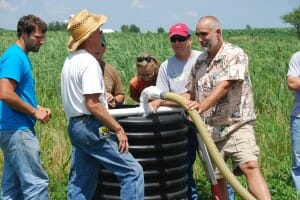Family Style Poultry Processing and Pasture Conversion
On July 15 the Cory family in Elkhart opened their farm to an interested crowd for a unique two-part Field Day. The whole family was on hand including Tom, Mary, Spencer, Gavin, Luke, James, and Lorinda as well as Grandpa & Grandma Jim and Mary-Ann Mathis.
Both topics are of special interest across the midwest and within Practical Farmers.
The day started with a hands-on poultry processing demonstration featuring a full line-up of Featherman equipment. The kill cones, scalder with roto-dunker, and plucker were great to see in action along with various types of knives, eviscerators, and shrink bags for packing the birds ready for sale. Of special interest for those starting-out with on-farm processing was the overall setup of tables, overhead water lines, gloves, aprons, etc in addition to the Featherman equipment. 
The Cory’s patient expertise and thorough communication about using the equipment was enlightening. It was clear how much time and effort the Cory’s have put into research and practice to get it right for their customers. Attendees picked-up many helpful insights that typically require seasons and hundreds of birds’ experience to get. For example the Cory’s make their own ice blocks in buckets ahead of time to avoid buying bags of ice for carcass chilling. The hands-on nature of the field day allowed several attendees to actually handle knives and eviscerate the birds themselves. 
A homemade PVC rack held the birds to drip-dry before being packed into form-fitting shrink bags. Mary immediately weighs and labels the birds to keep a running tally of their inventory before getting busy with other things. A brief pasture walk at the home place exposed what the Cory’s are so busy with. Attendees saw the pens where the pastured poultry are raised as well as a chore wagon that keeps essentials with the birds. The group also saw the free-range egg operation and a large herd of ewes and lambs on pasture at the home place.
After lunch the event moved to a different farm where a 5-year effort to change row-crop ground to perennial pasture for a rotational grazing system was discussed. The brand new fences, fresh seedings, electric nets, water tanks, and recently harvested oats were in stark contrast to the surrounding corn and beans. Tom spoke thoroughly about the process of making the change. 
He explained how the economics of corn-to-pasture may not look good right now, they charge their grazing operation $200 an acre rent, but they know it will work over time. He discussed building the fences, seeding the pastures, and water access. Experiments with alternative management like Sea-90 and raw milk treatments were outlined, and a brix test demonstration interested everyone on the hay rack.
At the end of the long day attendees were sunburned and buzzing with ideas about their own grazing systems and potential poultry operations.
